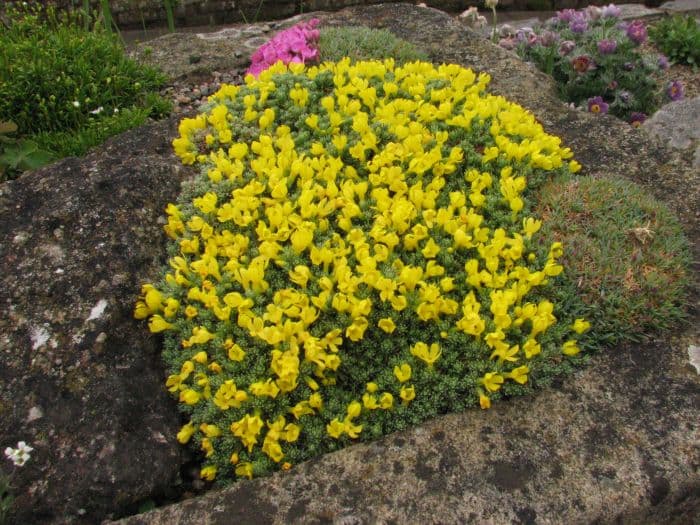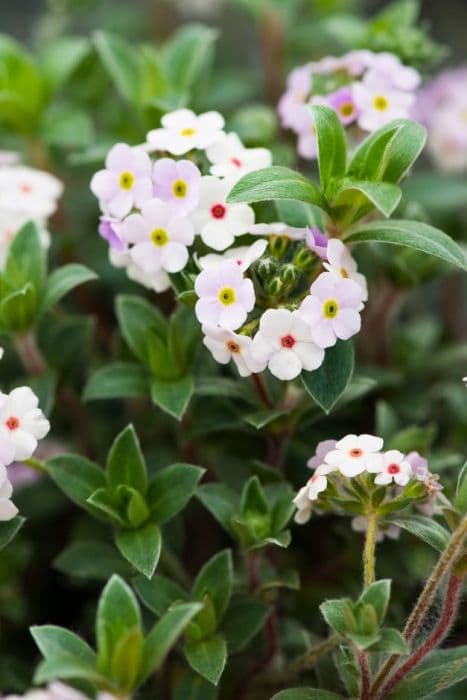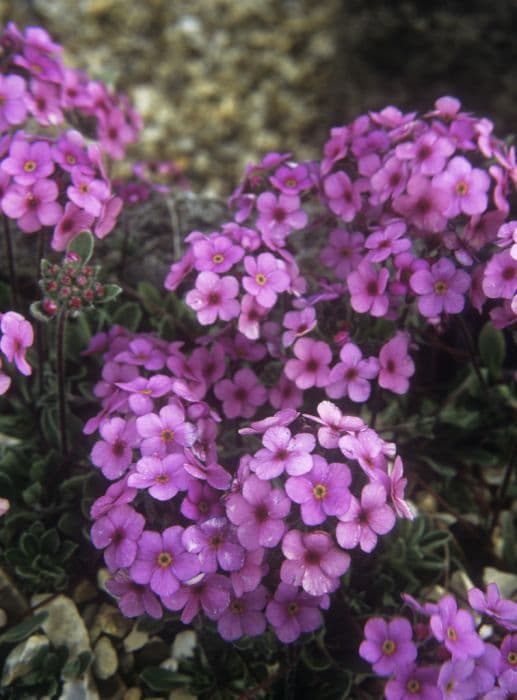Goldfinger Vitaliana primuliflora

ABOUT
Vitaliana primuliflora, commonly known as gold basket, is a perennial plant characterized by its vibrant flower display and attractive foliage. The plant typically forms a low, cushion-like mound, and its leaves are small, oblong to spoon-shaped, with a fleshy texture that gives it a succulent appearance. The foliage is often a green to grayish-green hue, sometimes with a silvery sheen, and can create a dense, mat-like groundcover. The most eye-catching feature of the gold basket is its bright yellow flowers, which bloom abundantly and can cover the foliage almost completely when in full display. Each flower has a tubular base that flares out into a star-shaped array of petals. These petals are bright and glossy, commanding attention with their sunshine-like color. The flowers are clustered at the ends of short stalks that rise slightly above the leaves, forming a cheerful and dense display of blooms. Overall, the appearance of the gold basket is one of a lush, compact mound of greenery studded with radiant yellow flowers, creating a striking visual contrast and a point of interest in rocky or alpine garden settings, where it is often cultivated for its ornamental appeal. The plant is particularly valued for its ability to thrive in challenging conditions and its low maintenance needs, alongside the splash of color it provides to the landscape.
About this plant
 Names
NamesFamily
Primulaceae
Synonyms
Gold Basket, Primula-flowered Vitaliana
Common names
Androsace primuliflora, Douglasia vitaliana.
 Toxicity
ToxicityTo humans
There is limited information available regarding the toxicity of Vitaliana primuliflora, also known as goldmoss, to humans. It is not commonly known as a toxic plant, and there are no widely reported cases of poisoning from its ingestion. Therefore, no specific symptoms or consequences can be provided. However, as with any plant, some individuals may have allergic reactions or sensitivities. It is always advisable to exercise caution and avoid ingesting plants that are not commonly recognized as edible.
To pets
Similar to the information available for humans, there is limited specific knowledge regarding the toxicity of goldmoss to pets. It is not noted for being a poisonous plant, and there isn't a record of pets being poisoned by ingestion of Vitaliana primuliflora. Nevertheless, caution should be taken as some plants that are not toxic to humans can still be harmful to pets. If a pet ingests an unknown plant, it is always a good practice to observe the animal closely and consult a veterinarian if any adverse reactions occur.
 Characteristics
CharacteristicsLife cycle
Perennials
Foliage type
Evergreen
Color of leaves
Green
Flower color
Yellow
Height
0.16 feet (5 cm)
Spread
0.5 feet (15 cm)
Plant type
Herb
Hardiness zones
5
Native area
Europe
Benefits
 General Benefits
General Benefits- Aesthetic Appeal: Vitaliana primuliflora, commonly known as Goldilocks, adds vibrant yellow flowers to gardens, rockeries, and alpine settings, enhancing visual interest.
- Drought Resistance: Goldilocks is adapted to thrive in dry conditions, making it a suitable choice for water-wise landscaping and areas with water restrictions.
- Low Maintenance: Once established, this plant requires minimal care, making it ideal for gardeners seeking low-effort plants.
- Wildlife Attraction: The flowers of Goldilocks can attract pollinators like bees and butterflies, contributing to the biodiversity of the garden.
- Soil Erosion Control: The mat-forming growth habit of Goldilocks helps to stabilize the soil, particularly beneficial on slopes and in rock gardens to prevent erosion.
- Cold Tolerance: Goldilocks is resilient to cold temperatures and can survive in high-altitude or northern climates, where other plants may fail.
- Container Gardening: Its compact size makes it suitable for container gardening, allowing it to be featured on patios, balconies, and other small spaces.
 Medical Properties
Medical PropertiesThis plant is not used for medical purposes.
 Air-purifying Qualities
Air-purifying QualitiesThis plant is not specifically known for air purifying qualities.
 Other Uses
Other Uses- Garden rockeries: Vitaliana primuliflora is often used in rock gardens due to its ability to thrive in rocky, well-drained soils and enhance the aesthetic with its bright yellow flowers.
- Alpine plant collections: The plant is a popular choice among alpine plant enthusiasts who cultivate collections of mountain-dwelling flora.
- Ground cover: Its low-growing, mat-forming habit makes it suitable for ground cover, helping to prevent soil erosion on slopes.
- Container gardens: Due to its compact size, Vitaliana primuliflora is suitable for container gardening, where it can be displayed on balconies or patios.
- Edging plants: The plant is used to define garden paths or borders, as its evergreen leaves provide year-round structure and color.
- Bee gardens: Vitaliana primuliflora attracts pollinators such as bees which makes it a valuable addition to gardens designed to support bee populations.
- Photographic subjects: The bright flowers and attractive foliage make this plant a popular subject for photographers, especially those specializing in botanical themes.
- Eco-friendly landscaping: This plant is used in xeriscaping, a landscaping method that reduces or eliminates the need for supplemental water from irrigation.
- Wildlife habitats: It provides shelter and potential nesting sites for small ground-dwelling invertebrates.
- Cultural significance: In some regions, Vitaliana primuliflora is incorporated into traditional gardens and landscapes for its cultural and historical significance.
Interesting Facts
 Feng Shui
Feng ShuiThe Vitaliana primuliflora is not used in Feng Shui practice.
 Zodiac Sign Compitability
Zodiac Sign CompitabilityThe Vitaliana primuliflora is not used in astrology practice.
 Plant Symbolism
Plant Symbolism- Resilience: Gold Primrose thrives in high-altitude environments and harsh conditions, symbolizing the ability to withstand challenges and recover from adversity.
- Adaptability: This plant's ability to adapt to extreme weather and poor soil conditions represents versatility and the capability to thrive in diverse and difficult circumstances.
- Rarity: As a plant that is not commonly found, Gold Primrose can symbolize uniqueness and value in rarity, and the beauty of being one-of-a-kind.
- Renewal and Hope: Blossoming in the spring, Gold Primrose represents new beginnings, the rebirth of nature, and the perpetual hope that comes with each new season.
 Water
WaterThe Goldmoss, also known as Vitaliana primuliflora, prefers consistent moisture without becoming waterlogged. Water the plant deeply but infrequently, ensuring that the soil is allowed to dry out slightly between waterings. Depending on the environment, this equates to approximately 8-16 ounces of water per week during its growing season. During winter and cooler months, reduce watering to every other week or less, depending on soil dryness, providing only enough water to prevent the soil from completely drying out.
 Light
LightFor Goldmoss, it is essential to provide full sunlight to ensure healthy growth and flowering. An ideal spot would be either a south-facing or west-facing position where the plant can receive direct sunlight for most of the day. Avoid placing it in deep shade, as this will hinder its growth and blooming potential.
 Temperature
TemperatureGoldmoss thrives in cool to moderate temperature conditions and can endure minimum temperatures down to about 20°F. Its ideal growing temperatures range from 50°F to 70°F. Extreme heat is detrimental to the plant, so during high summer temperatures, providing some afternoon shade can be beneficial.
 Pruning
PruningPruning Goldmoss is not typically necessary, but if you need to shape the plant or remove any damaged or dead foliage, do so in the early spring before new growth begins. It's a low-maintenance plant, and the occasional tidying up will help maintain its compact form and encourage healthy new growth.
 Cleaning
CleaningAs needed
 Soil
SoilThe best soil mix for Goldmoss (Vitaliana primuliflora) should be well-draining with a mix of sand, peat, and loam in equal parts, ensuring good aeration and avoiding waterlogging. The soil pH should lean towards neutral to slightly acidic, with an ideal pH range of 6.0 to 7.0 for optimal growth.
 Repotting
RepottingGoldmoss does not typically require frequent repotting; it should be repotted every 2-3 years or when it has outgrown its container. Ensure the new pot is only slightly larger to avoid excessive moisture which can lead to root rot.
 Humidity & Misting
Humidity & MistingGoldmoss is adapted to alpine conditions so it prefers lower humidity levels. However, it can tolerate a range of humidity levels provided that there is good air circulation and the soil drainage is adequate to compensate for humidity.
 Suitable locations
Suitable locationsIndoor
Place Goldmoss in bright, indirect light and ensure good air flow.
Outdoor
Grow Goldmoss in alpine rock gardens with full sun exposure.
Hardiness zone
4-8 USDA
 Life cycle
Life cycleThe life cycle of Vitaliana primuliflora, also known as goldmoss stonecrop, begins with seed germination, which typically occurs in spring or early summer when environmental conditions are suitable. Once germinated, the seedlings develop into juvenile plants, establishing a root system and beginning to form rosettes of fleshy leaves. As the plants mature, they enter the vegetative stage, during which they grow and proliferate through vegetative propagation, spreading by offsets. Upon reaching maturity, the goldmoss stonecrop produces bright yellow flowers, usually in the late spring or early summer, which are pollinated by insects, leading to seed formation. After pollination and seed set, the plant may go through a period of dormancy, especially in climates with cold winters. Finally, the life cycle is completed when the mature plant dies after several years, having produced numerous seeds to ensure the continuation of the species.
 Propogation
PropogationPropogation time
Spring to Early Summer
Propogation: The common name for Vitaliana primuliflora is Goldmoss, and the most popular method of propagating this alpine plant is through seed sowing. For best results, seeds should be sown in the fall inside containers in a cold frame. Cold frames provide a controlled environment with a transparent roof to protect seeds from extreme weather while still allowing sunlight to enter. Seeds of the Goldmoss typically require a period of cold stratification to break dormancy, a process naturally achieved by the winter cold. Once spring arrives and temperatures begin to warm, the seeds will germinate. Seedlings can then be carefully transplanted into individual pots and grown on until they are large enough to be planted out in their permanent positions in the garden during the following spring.









